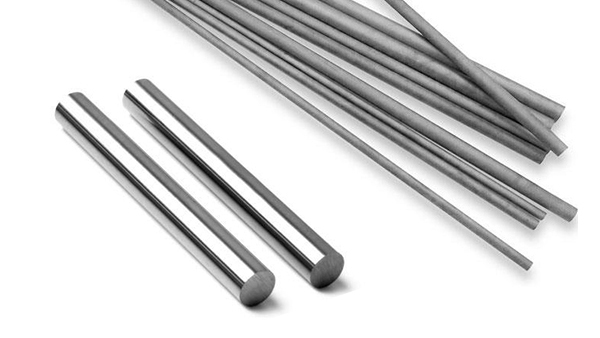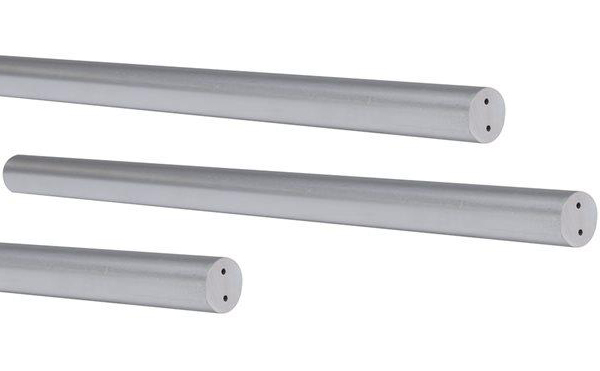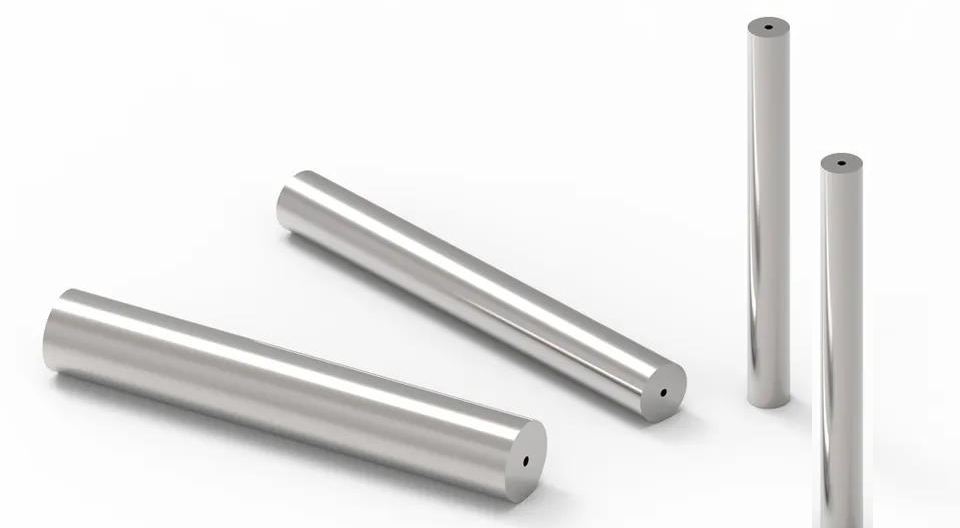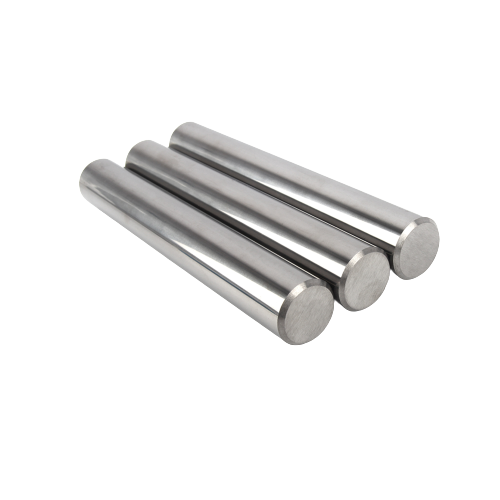공차가 미크론 단위로 측정되고 성능이 가장 중요한 고정밀 기계 가공의 세계에서, solid 카바이드 로드 최고를 지배합니다. 놀랍도록 단단하고 내마모성이 뛰어난 텅스텐 카바이드로 제작된 이 놀라운 엔지니어링 제품은 항공 우주에서 의료에 이르기까지 다양한 산업을 이끄는 수많은 절삭 공구와 마모 부품의 근간을 형성합니다.
하지만 모든 카바이드 봉이 똑같이 만들어지는 것은 아닙니다. 이 포괄적인 가이드에서는 네 가지 필수 요소의 복잡성에 대해 자세히 설명합니다. 솔리드 카바이드 로드 유형은 각각 특정 가공 과제에 맞는 고유한 기능과 장점을 갖추고 있습니다:
- 직선형 절삭유 홀 카바이드 로드
- 직선 절삭유 홀 카바이드 로드 2개
- 2 헬리컬 절삭유 홀 카바이드 로드
- 엔드 챔퍼 그라운드 카바이드 로드
이 가이드는 초경봉의 고유한 특성 이해부터 다양한 응용 분야 탐색에 이르기까지 초경봉의 세계를 탐색하고 정밀 가공 요구 사항에 맞는 완벽한 유형을 선택할 수 있는 지식을 제공합니다.
개요 손 안의 정밀함의 힘
초경합금 봉은 강철 봉과 달리 극한의 온도에서도 경도와 강도를 유지하므로 열 발생이 우려되는 고속 가공 작업에 이상적입니다. 내마모성이 뛰어나 공구 수명을 연장하고 가동 중단 시간을 줄이며 궁극적으로 제조 비용을 절감할 수 있습니다.
절삭유 구멍 및 기타 기능을 추가하여 성능을 더욱 향상시켜 효율적인 칩 배출, 열 방출 개선, 절삭 속도 증가를 가능하게 함으로써 정밀 가공의 한계를 뛰어넘었습니다.
자세한 소개: 초경합금 막대의 세계 탐험하기
솔리드 카바이드 로드란?
솔리드 카바이드 로드는 이름에서 알 수 있듯이 뛰어난 경도와 내마모성으로 유명한 초경합금 소재인 텅스텐 카바이드로 만든 원통형 막대입니다. 이 막대는 다양한 산업에서 사용되는 광범위한 절삭 공구 및 마모 부품을 제조하는 데 사용되는 시작 재료로 사용됩니다.
가공에서 카바이드 로드 작동 원리
초경봉은 절삭 공구로 가공할 때 다음과 같은 원리에 따라 작동합니다. 전단 변형. 로드 재료로 형성된 초경 공구의 매우 단단한 절삭날은 재료의 전단 강도를 초과하여 공작물을 절단할 수 있습니다. 절삭 공구의 형상은 절삭 매개변수와 함께 절삭의 효율성과 품질을 결정합니다.
솔리드 카바이드 로드는 어떻게 사용되나요?
초경봉은 일반적으로 다음과 같은 다양한 절삭 공구로 가공됩니다:
- 엔드 밀: 셰이핑 및 프로파일링 작업용.
- 훈련: 다양한 소재에 구멍을 만들 수 있습니다.
- 리머: 기존 구멍을 확대하고 마무리하는 데 사용합니다.
- 사용자 지정 도구: 특정 가공 요구 사항에 맞게 조정됩니다.
솔리드 카바이드 로드는 어떻게 가공되나요?
초경봉을 가공하려면 경도가 매우 높기 때문에 특수 장비와 기술이 필요합니다. 다이아몬드 연삭 휠은 일반적으로 카바이드 봉을 성형하고 마무리하는 데 사용됩니다. 고성능 절삭 공구에 필요한 엄격한 공차와 복잡한 형상을 구현하기 위해 CNC로 제어되는 정밀 연삭기가 사용됩니다.
솔리드 카바이드 로드 분류 및 유형
솔리드 카바이드 막대는 다음과 같은 다양한 요소에 따라 분류됩니다:
- 카바이드 등급: 막대의 경도, 인성 및 내마모성을 결정합니다.
- 지름과 길이: 다양한 표준 및 사용자 지정 크기로 제공됩니다.
- 냉각수 구멍 구성: 직선형, 나선형 또는 냉각수 구멍이 없습니다.
- 표면 마감: 연마, 광택 또는 코팅.
초경합금 로드 시장 동향
특히 항공우주, 자동차, 의료 등의 산업에서 첨단 제조 기술의 채택이 증가함에 따라 초경 봉재에 대한 전 세계 수요가 증가하고 있습니다. 이 시장은 제조업체들이 향상된 성능과 비용 효율성을 제공하는 새로운 초경 재종과 공구 디자인을 개발하기 위해 끊임없이 혁신하는 등 경쟁이 치열한 것이 특징입니다.
4가지 필수 솔리드 카바이드 로드 유형을 공개합니다: 비교 분석
| 기능 | 솔리드 카바이드 로드 | 직선형 냉각수 구멍 1개 | 2개의 직선형 냉각수 구멍 | 2개의 나선형 냉각수 구멍 | 1 엔드 챔퍼 접지 |
|---|---|---|---|---|---|
| 이미지 | |||||
| 설명 | 텅스텐 카바이드로 만든 단단한 원통형 막대입니다. | 중앙에 하나의 직선형 냉각수 구멍이 있는 솔리드 카바이드 로드입니다. | 두 개의 평행한 직선형 냉각수 구멍이 있는 솔리드 카바이드 로드. | 칩 배출을 강화하기 위해 두 개의 나선형 냉각수 구멍이 있는 솔리드 카바이드 로드. | 정확한 공구 길이 설정을 위해 한쪽 끝을 챔퍼링하고 정밀 연마한 솔리드 카바이드 로드입니다. |
| 냉각수 흐름 | 없음 | 관통 절삭유 | 관통 절삭유 | 관통 절삭유 | 없음 |
| 칩 대피 | 제한 | 개선됨 | 더욱 개선됨 | 우수 | 제한 |
| 애플리케이션 | 범용 가공, 마모 부품 | 드릴링, 리밍, 밀링 | 깊은 구멍 드릴링, 대량 가공 | 고성능 가공, 가공하기 어려운 재료 | 공구 비트 블랭크, 맞춤형 공구 제작 |
| 장점 | 비용 효율적이고 다양한 활용성 | 향상된 칩 제거, 향상된 냉각 | 균형 잡힌 냉각수 흐름, 향상된 강성 | 최적의 칩 제거, 더 빠른 절단 속도 | 정확한 공구 길이, 설정 시간 단축 |
| 제한 사항 | 칩 제거는 어려울 수 있습니다. | 단일 냉각수 구멍으로 인해 냉각수 흐름이 제한될 수 있습니다. | 나선형 구멍은 막대의 구조를 약화시킬 수 있습니다. | 직선형 냉각수 구멍보다 더 비싸다 | 관통형 절삭유 응용 분야에는 적합하지 않음 |
표 1: 4가지 필수 솔리드 카바이드 로드 유형 비교 분석




애플리케이션: 정밀성이 가장 중요한 분야
초경합금 봉의 다재다능함은 여러 산업 분야에 걸쳐 다양한 용도로 활용되고 있습니다:
- 항공우주: 엔진 부품, 터빈 블레이드 및 구조 부품 제조.
- 자동차: 엔진 부품, 변속기 기어, 베어링을 생산합니다.
- 의료: 수술 기구, 임플란트 및 치과용 도구 제작.
- 금형 제작: 플라스틱 사출 성형, 다이캐스팅 및 기타 공정을 위한 금형 제작.
- 에너지: 석유 및 가스 탐사 및 발전용 시추 및 가공 부품을 제작합니다.
- 전자 제품: 전자 부품 및 회로 기판의 미세 가공.
장점과 한계: 장단점 비교하기
| 기능 | 장점 | 제한 사항 |
|---|---|---|
| 경도 및 내마모성 | 경도와 내마모성이 뛰어나 공구 수명이 길어지고 절삭 성능이 향상됩니다. | 충격이나 진동이 심한 조건에서 부서지기 쉽고 깨지기 쉽습니다. |
| 고온 안정성 | 고온에서도 경도와 강도를 유지하여 고속 가공 작업을 가능하게 합니다. | 초경 가공은 경도가 매우 높기 때문에 전문 장비와 전문 지식이 필요합니다. |
| 내식성 | 부식 및 화학적 공격에 대한 내성이 강해 열악한 환경에서 사용하기에 적합합니다. | 고속 강철과 같은 다른 공구 재료보다 더 비쌀 수 있습니다. |
표 2: 초경합금의 장점과 한계
관련 인사이트: 카바이드 지평의 확장
- 카바이드 등급 선택의 중요성: 공구 성능과 수명을 최적화하려면 올바른 카바이드 재종을 선택하는 것이 중요합니다. 고려해야 할 요소에는 가공되는 재료, 절삭 속도, 이송 속도 및 필요한 표면 조도가 포함됩니다.
- 초경 공구 성능에서 코팅의 역할: 초경 공구의 내마모성, 윤활성, 내산화성을 더욱 향상시키기 위해 TiN, TiAlN, 다이아몬드 유사 탄소(DLC) 등의 코팅을 사용할 수 있습니다.
- 카바이드 로드 제조의 발전: 분말 야금 및 소결 공정의 혁신으로 더 미세한 입자 구조와 인성 증가 등 향상된 특성을 가진 새로운 초경 재종이 개발되고 있습니다.
자주 묻는 질문: 카바이드 로드 쿼리 해결
1. 솔리드 카바이드 로드와 카바이드 인서트의 주요 차이점은 무엇인가요?
솔리드 카바이드 로드는 전체 절삭 공구를 제조하는 데 사용되며, 카바이드 인서트는 공구 홀더에 부착되는 인덱서블 절삭 날입니다. 초경 공구는 더 높은 강성을 제공하며 일반적으로 고정밀 응용 분야에 사용되는 반면, 초경 인서트는 다목적성과 비용 효율성을 제공합니다.
2. 내 애플리케이션에 적합한 냉각수 구멍 구성을 선택하려면 어떻게 해야 하나요?
절삭유 구멍 구성의 선택은 가공 작업, 절삭되는 소재 및 원하는 칩 배출에 따라 달라집니다. 직선형 절삭유 구멍은 범용 가공에 적합하며, 나선형 구멍은 칩 제거가 중요한 고성능 응용 분야에 탁월합니다.
3. 솔리드 카바이드 공구를 재연마하거나 재연마할 수 있나요?
예, 초경 공구는 여러 번 재연마하거나 재연마할 수 있으므로 수명이 연장되고 공구 비용이 절감됩니다. 하지만 카바이드가 손상되지 않도록 특수 연삭 장비와 기술을 사용하는 것이 중요합니다.
4. 초경합금 봉과 공구를 취급할 때 주의해야 할 안전 수칙은 무엇인가요?
카바이드는 매우 단단하여 충격 시 부서질 수 있습니다. 카바이드를 다룰 때는 항상 보안경, 장갑, 적절한 복장을 착용하세요. 카바이드를 가공할 때는 칩이 매우 날카롭고 뜨거울 수 있으므로 주의를 기울이세요.
5. 고품질 솔리드 카바이드 막대는 어디에서 구할 수 있나요?
평판이 좋은 카바이드 로드 제조업체 및 공급업체는 특정 요구 사항을 충족하는 고품질 제품을 제공할 수 있습니다. 공급업체를 선택할 때는 경험, 품질 인증, 고객 지원 등의 요소를 고려하세요.
저렴한 텅스텐 카바이드 막대를 좋은 가격에 구입하고 싶으십니까? 여기.




